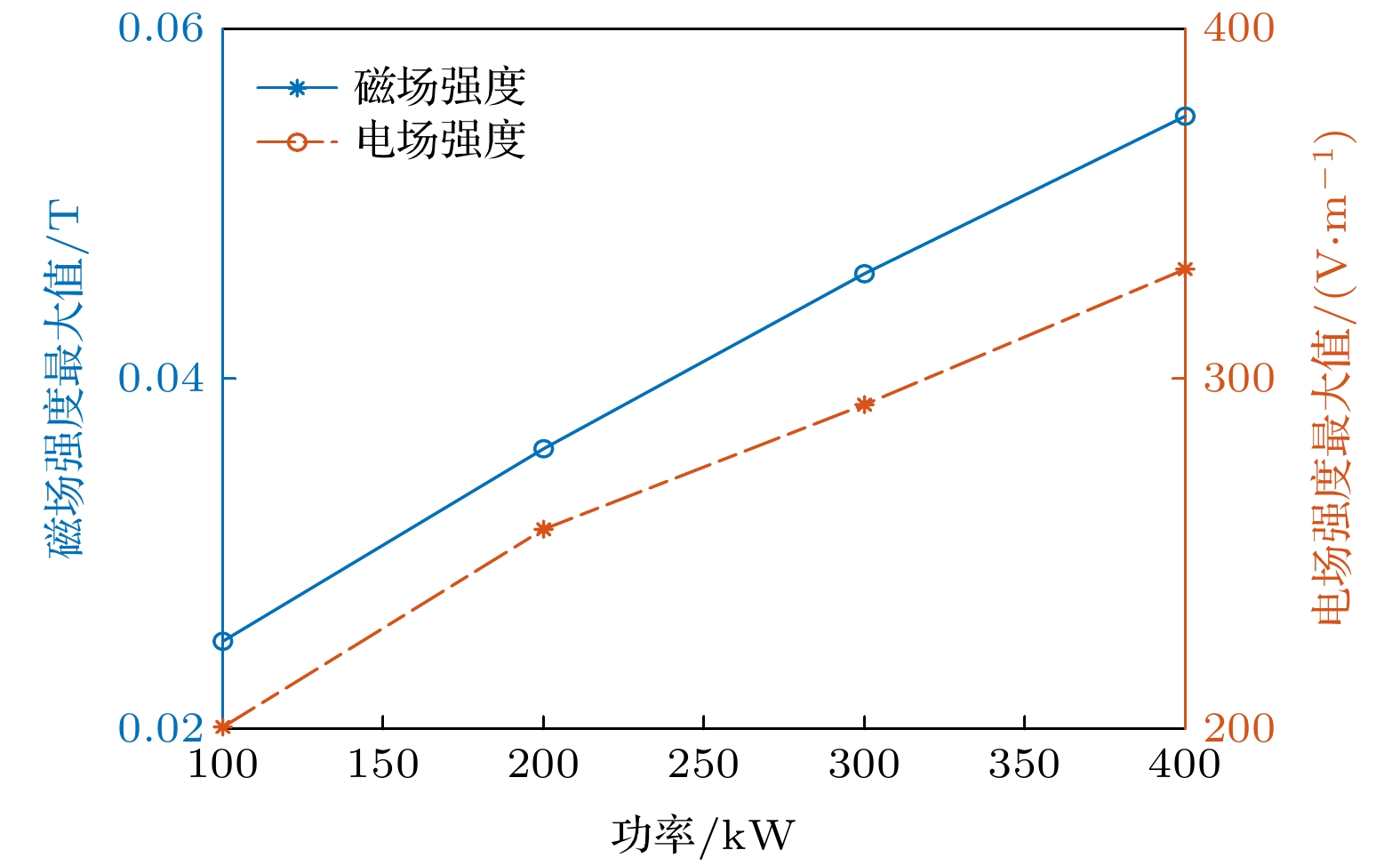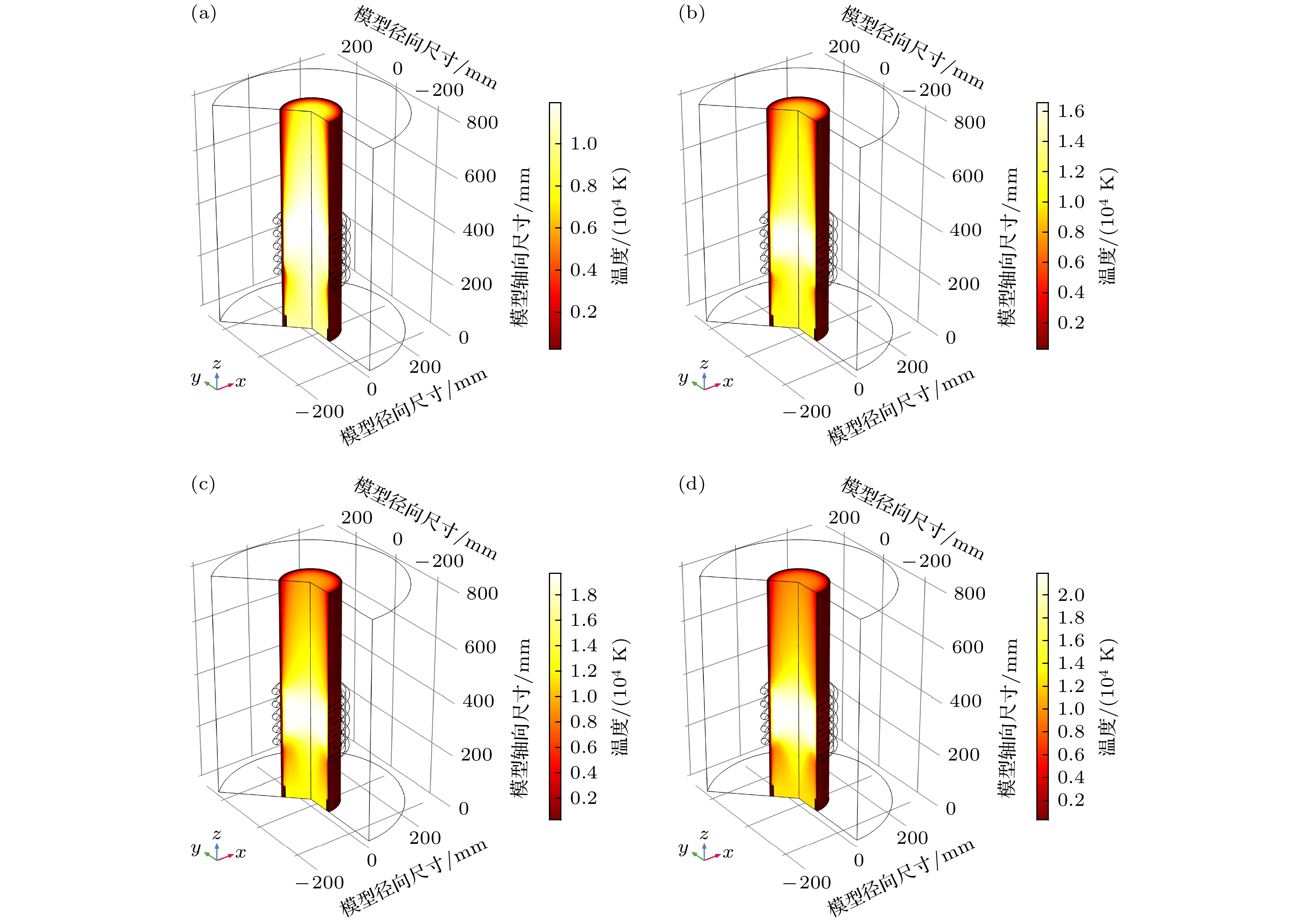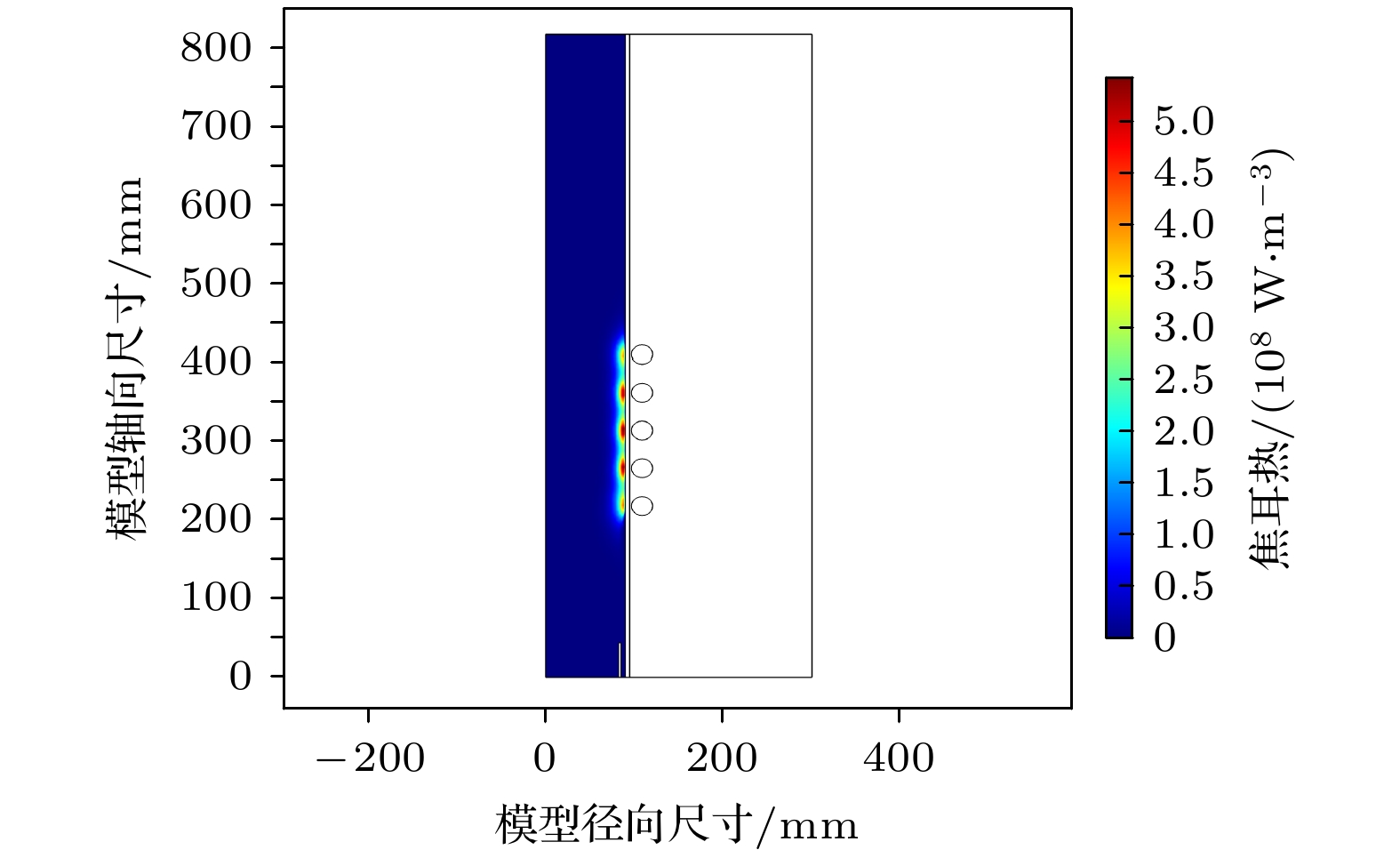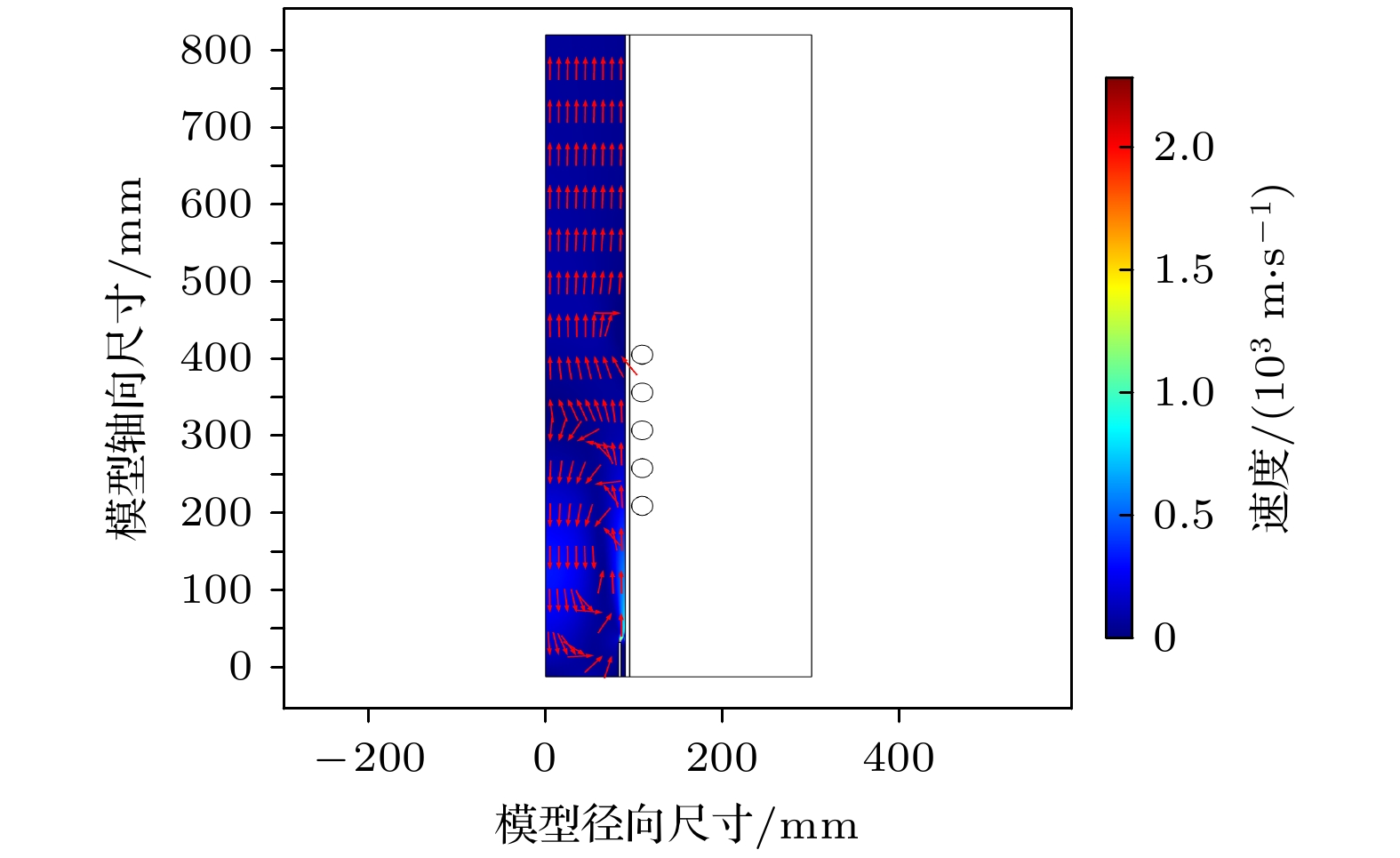-
Inductively coupled plasma generator is one of the core components of the near-space high-speed target plasma electromagnetic scientific experimental research device, which is often used to simulate high enthalpy and high speed plasma sheath environment. In order to study the discharge characteristics of inductively coupled plasma generator under high power, radio frequency and medium pressure, the numerical simulation and experiment are combined to study its internal heat transfer and flow characteristics in this paper. Based on the local thermodynamic equilibrium conditions, the numerical simulation of large-scale radio frequency and medium pressure inductively coupled plasma with a power of 100–400 kW is carried out through the multi-field coupling of flow, electromagnetic and temperature field, and verified by light intensity and spectrum experiment. The results show that the electromagnetic field distribution in the high-power thermal balance inductively coupled plasma generator is similar to that of the small- and medium-sized power plasma generator. The discharge energy dissipation occurs mainly in the area where the induction coil is located. The temperature of the inner wall of the quartz tube is higher at the coil location than in other areas, and the plasma has a ring-shaped high-temperature structure. The outer wall of the quartz tube is set to be the boundary condition of heat flux for simulating the temperature change of the quartz tube under cold blowing. This setting is in coincidence with factual situations. The wall temperature of the quartz tube at the entrance and at the induction coil section are found to be relatively high. When the large-size inductively coupled plasma generator works, an obvious return vortex is generated at the entrance due to the temperature difference and the electromagnetic pumping effect, and the exit velocity increases slightly with the increase of power. At the same time, the discharge experiment under the corresponding conditions shows that there is found a ring structure with bright edges and dark centers in the axial image of the argon discharge. Moreover, the emission spectrum of argon plasma is measured through the spectrum diagnosis system and the spatial distribution of the generator electron temperature is obtained. The light intensity of the discharge image and the electron temperature measured by the spectrum are found to be in comparative coincidence with the COMSOL simulation temperature result, demonstrating the validity of the numerical simulation results under thermodynamic equilibrium conditions. The numerical simulation results in this paper are also applicable to the optimization design and temperature resistance evaluation of the inductively coupled plasma generator.
-
Keywords:
- inductively coupled plasma /
- numerical simulation /
- experimental study /
- discharge phenomenon
[1] 龚旻, 谭杰, 李大伟, 马召, 田冠锁, 王暕来, 孟令涛 2018 宇航学报 39 1059
 Google Scholar
Google Scholar
Gong M, Tan J, Li D W, Ma Z, Tian G S, Wang J L, Meng L T 2018 J. Astronautics 39 1059
 Google Scholar
Google Scholar
[2] 魏小龙, 徐浩军, 李建海, 林敏, 宋慧敏 2015 64 175201
 Google Scholar
Google Scholar
Wei X L, Xu H J, Li J H, Lin M, Song H M 2015 Acta Phys. Sin. 64 175201
 Google Scholar
Google Scholar
[3] 喻明浩 2019 68 185202
 Google Scholar
Google Scholar
Yu M H 2019 Acta Phys. Sin. 68 185202
 Google Scholar
Google Scholar
[4] Mckelliget J W, El-Kaddah N 1987 MRS Proc. 98 21
 Google Scholar
Google Scholar
[5] Bernardi D, Colombo V, Ghedini E 2003 Eur. Phys. J. D 27 55
 Google Scholar
Google Scholar
[6] Ye R, Murphy A B, Ishigaki T 2007 Plasma Chem. Plasma Process. 27 189
 Google Scholar
Google Scholar
[7] Watanabe T, Sugimoto N 2004 Thin Solid Films 457 201
 Google Scholar
Google Scholar
[8] Punjabi S B, Joshi N K, Mangalvedekar H A, Lande B K, Das A K, Kothari D C 2012 Phys. Plasmas 19 012108
 Google Scholar
Google Scholar
[9] Lei F, Li X P, Liu Y M 2018 AIP Adv. 8 015003
 Google Scholar
Google Scholar
[10] Stewart R A, Vitello P, Graves D B 1994 J. Vac. Sci. Technol. 12 478
 Google Scholar
Google Scholar
[11] 马利斌 2019 硕士学位论文 (西安: 西安理工大学)
Ma L B 2019 M. S. Thesis (Xi’an: Xi’an University of Technology) (in Chinese)
[12] 陈熙 2009 热等离子体传热与流动 (北京: 科学出版社) 第29页
Chen X 2009 Thermal Plasma Heat Transfer and Flow (Beijing: Science Press) p29 (in Chinese)
[13] 王峰, 何立明, 兰宇丹, 杜宏亮, 俞健 2011 原子能科学技术 45 642
Wang F, He L M, Lan Y D, Du H L, Yu J 2011 Atmo. Energ. Sci. Technol. 45 642
[14] 辛仁轩 2018 等离子体发射光谱分析 (北京: 化学工业出版社) 第46, 47页
Xin R X 2005 Analysis of Plasma Emission Spectroscopy pp46, 47 (Beijing: Chemical Industry Press) (in Chinese)
[15] 刘丽萍, 王一光, 王国林, 罗杰, 马昊军 2018 航空学报 39 141
 Google Scholar
Google Scholar
Liu L P, Wang Y G, Wang G L, Luo J, Ma H J 2018 Acta Aeronautica et Astronautica Sinica 39 141
 Google Scholar
Google Scholar
[16] 高鑫鑫, 华伟, 张弘, 常颖 2019 四川大学学报 (自然科学版) 56 703
 Google Scholar
Google Scholar
Gao X X, Hua W, Zhang H, Chang Y 2019 J. Sichuan Univ.: Nat. Sci. Ed. 56 703
 Google Scholar
Google Scholar
[17] 朱海龙, 童洪辉, 叶高英, 陈伦江 2012 核聚变与等离子体物理 32 199
 Google Scholar
Google Scholar
Zhu H L, Tong H H, Ye G Y, Chen L J 2012 Nucl. Fus. Plas. Phys. 32 199
 Google Scholar
Google Scholar
[18] 金星, 段发鑫, 张晶晶, 张哲, 廖杨凡 2018 质谱学报 39 192
 Google Scholar
Google Scholar
Jin X, Duan F X, Zhang J J, Zhang Z, Liao Y F 2018 J. Chin. Mass Spectr. Soc. 39 192
 Google Scholar
Google Scholar
[19] 贾瑞宝, 罗天勇, 陈伦江 2018 核聚变与等离子体物理 38 473
 Google Scholar
Google Scholar
Jia R B, Luo T Y, Chen L J 2018 Nucl. Fus. Plas. phys. 38 473
 Google Scholar
Google Scholar
[20] Ikhlef N, Leroy O, Mekideche M R 2015 Contrib. Plasma Phys. 54 735
 Google Scholar
Google Scholar
[21] 李伟斌, 熊永红 2003 物理实验 23 9
Li W B, Xiong Y H 2003 Physics Experimentation 23 9
-
图 15 等离子体径向激发温度 (a) r = 30 mm,
${T_{\rm e}} = 1.103 \times{10^4}$ K; (b) r = 60 mm;${T_{\rm e}} = 1.199 \times {10^4}$ K; (c) r = 70 mm,${T_{\rm e}} = 1.136 \times {10^4}$ KFigure 15. Radial plasma excitation temperature: (a) r = 30 mm,
${T_{\rm e}} = 1.103 \times {10^4}$ K; (b) r = 60 mm,${T_{\rm e}} = 1.199 \times {10^4}$ K; (c) r = 70 mm${T_{\rm e}} = 1.136 \times {10^4}$ K表 1 基本计算参数
Table 1. Basic calculation parameters.
序号 模拟参数 数值 1 入口质量流/(g·s-1) 10 2 气压/Pa 1000 3 线圈功率/kW 100—400 4 频率/kHz 440 5 湍流强度 0.05 6 湍流长度/m 0.01 表 2 原子Ar I谱线的光谱学数据
Table 2. Spectroscopic data of atomic Ar I spectral line.
λ/nm Aki/s–1 Ek/eV gk 912.3 1.89 × 107 12.91 3 801.5 9.30 × 106 13.10 5 842.5 2.15 × 107 13.12 5 922.5 5.00 × 106 13.20 5 826.5 1.53 × 107 13.36 3 表 A1 氩等离子体的热力学与输运性质(0.01 atm, 热力学平衡)
Table A1. Thermodynamics and transport properties of argon plasma (0.01 atm, Thermodynamic equilibrium).
温度/K 密度/(kg·m–3) 定压比热/(J·kg–1·K–1) 黏度/(Pa·s) 热导率/(W·m–1·K–1) 电导率/(S·m–1) 1000 $4.87\times10^{-3}$ $5.21\times10^{2}$ $ 6.94\times10^{-5}$ $5.42\times10^{-2}$ $0\times 10^{0}$ 2000 $2.43\times10^{-3}$ $5.21\times10^{2}$ $ 1.03\times10^{-4}$ $8.04\times10^{-2}$ $1.09\times 10^{-10}$ 3000 $1.62\times10^{-3}$ $5.21\times10^{2}$ $ 1.32\times10^{-4}$ $1.03\times10^{-1}$ $6.06\times 10^{-4} $ 4000 $1.22\times10^{-3}$ $5.21\times10^{2}$ $ 1.58\times10^{-4}$ $1.24\times10^{-1}$ $8.44\times 10^{-1} $ 5000 $9.73\times10^{-4}$ $5.22\times10^{2}$ $ 1.84\times10^{-4}$ $1.45\times10^{-1}$ $4.31\times 10^{1} $ 6000 $8.10\times10^{-4}$ $5.49\times10^{2}$ $ 2.08\times10^{-4}$ $1.80\times10^{-1}$ $3.05\times 10^{2} $ 7000 $6.93\times10^{-4}$ $7.48\times10^{2}$ $ 2.31\times10^{-4}$ $2.61\times10^{-1}$ $9.17\times 10^{2} $ 8000 $5.98\times10^{-4}$ $1.60\times10^{3}$ $ 2.46\times10^{-4}$ $4.54\times10^{-1}$ $1.60\times 10^{3} $ 9000 $5.07\times10^{-4}$ $4.14\times10^{3}$ $ 2.26\times10^{-4}$ $8.48\times10^{-1}$ $2.26\times 10^{3} $ 10000 $4.04\times10^{-4}$ $9.28\times10^{3}$ $ 1.51\times10^{-4}$ $1.50\times10^{0}$ $2.88\times 10^{3} $ 11000 $3.00\times10^{-4}$ $1.48\times10^{4}$ $ 6.99\times10^{-5}$ $1.98\times10^{0}$ $3.46\times 10^{3} $ 12000 $2.29\times10^{-4}$ $1.13\times10^{4}$ $ 2.65\times10^{-5}$ $1.56\times10^{0}$ $3.95\times 10^{3} $ 13000 $1.95\times10^{-4}$ $4.96\times10^{3}$ $ 1.19\times10^{-5}$ $1.06\times10^{0}$ $4.37\times 10^{3} $ 14000 $1.76\times10^{-4}$ $2.41\times10^{3}$ $ 8.18\times10^{-5}$ $9.32\times10^{-1}$ $4.76\times 10^{3} $ 15000 $1.63\times10^{-4}$ $1.94\times10^{3}$ $ 7.59\times10^{-5}$ $9.86\times10^{-1}$ $5.15\times 10^{3} $ -
[1] 龚旻, 谭杰, 李大伟, 马召, 田冠锁, 王暕来, 孟令涛 2018 宇航学报 39 1059
 Google Scholar
Google Scholar
Gong M, Tan J, Li D W, Ma Z, Tian G S, Wang J L, Meng L T 2018 J. Astronautics 39 1059
 Google Scholar
Google Scholar
[2] 魏小龙, 徐浩军, 李建海, 林敏, 宋慧敏 2015 64 175201
 Google Scholar
Google Scholar
Wei X L, Xu H J, Li J H, Lin M, Song H M 2015 Acta Phys. Sin. 64 175201
 Google Scholar
Google Scholar
[3] 喻明浩 2019 68 185202
 Google Scholar
Google Scholar
Yu M H 2019 Acta Phys. Sin. 68 185202
 Google Scholar
Google Scholar
[4] Mckelliget J W, El-Kaddah N 1987 MRS Proc. 98 21
 Google Scholar
Google Scholar
[5] Bernardi D, Colombo V, Ghedini E 2003 Eur. Phys. J. D 27 55
 Google Scholar
Google Scholar
[6] Ye R, Murphy A B, Ishigaki T 2007 Plasma Chem. Plasma Process. 27 189
 Google Scholar
Google Scholar
[7] Watanabe T, Sugimoto N 2004 Thin Solid Films 457 201
 Google Scholar
Google Scholar
[8] Punjabi S B, Joshi N K, Mangalvedekar H A, Lande B K, Das A K, Kothari D C 2012 Phys. Plasmas 19 012108
 Google Scholar
Google Scholar
[9] Lei F, Li X P, Liu Y M 2018 AIP Adv. 8 015003
 Google Scholar
Google Scholar
[10] Stewart R A, Vitello P, Graves D B 1994 J. Vac. Sci. Technol. 12 478
 Google Scholar
Google Scholar
[11] 马利斌 2019 硕士学位论文 (西安: 西安理工大学)
Ma L B 2019 M. S. Thesis (Xi’an: Xi’an University of Technology) (in Chinese)
[12] 陈熙 2009 热等离子体传热与流动 (北京: 科学出版社) 第29页
Chen X 2009 Thermal Plasma Heat Transfer and Flow (Beijing: Science Press) p29 (in Chinese)
[13] 王峰, 何立明, 兰宇丹, 杜宏亮, 俞健 2011 原子能科学技术 45 642
Wang F, He L M, Lan Y D, Du H L, Yu J 2011 Atmo. Energ. Sci. Technol. 45 642
[14] 辛仁轩 2018 等离子体发射光谱分析 (北京: 化学工业出版社) 第46, 47页
Xin R X 2005 Analysis of Plasma Emission Spectroscopy pp46, 47 (Beijing: Chemical Industry Press) (in Chinese)
[15] 刘丽萍, 王一光, 王国林, 罗杰, 马昊军 2018 航空学报 39 141
 Google Scholar
Google Scholar
Liu L P, Wang Y G, Wang G L, Luo J, Ma H J 2018 Acta Aeronautica et Astronautica Sinica 39 141
 Google Scholar
Google Scholar
[16] 高鑫鑫, 华伟, 张弘, 常颖 2019 四川大学学报 (自然科学版) 56 703
 Google Scholar
Google Scholar
Gao X X, Hua W, Zhang H, Chang Y 2019 J. Sichuan Univ.: Nat. Sci. Ed. 56 703
 Google Scholar
Google Scholar
[17] 朱海龙, 童洪辉, 叶高英, 陈伦江 2012 核聚变与等离子体物理 32 199
 Google Scholar
Google Scholar
Zhu H L, Tong H H, Ye G Y, Chen L J 2012 Nucl. Fus. Plas. Phys. 32 199
 Google Scholar
Google Scholar
[18] 金星, 段发鑫, 张晶晶, 张哲, 廖杨凡 2018 质谱学报 39 192
 Google Scholar
Google Scholar
Jin X, Duan F X, Zhang J J, Zhang Z, Liao Y F 2018 J. Chin. Mass Spectr. Soc. 39 192
 Google Scholar
Google Scholar
[19] 贾瑞宝, 罗天勇, 陈伦江 2018 核聚变与等离子体物理 38 473
 Google Scholar
Google Scholar
Jia R B, Luo T Y, Chen L J 2018 Nucl. Fus. Plas. phys. 38 473
 Google Scholar
Google Scholar
[20] Ikhlef N, Leroy O, Mekideche M R 2015 Contrib. Plasma Phys. 54 735
 Google Scholar
Google Scholar
[21] 李伟斌, 熊永红 2003 物理实验 23 9
Li W B, Xiong Y H 2003 Physics Experimentation 23 9
Catalog
Metrics
- Abstract views: 10202
- PDF Downloads: 177
- Cited By: 0














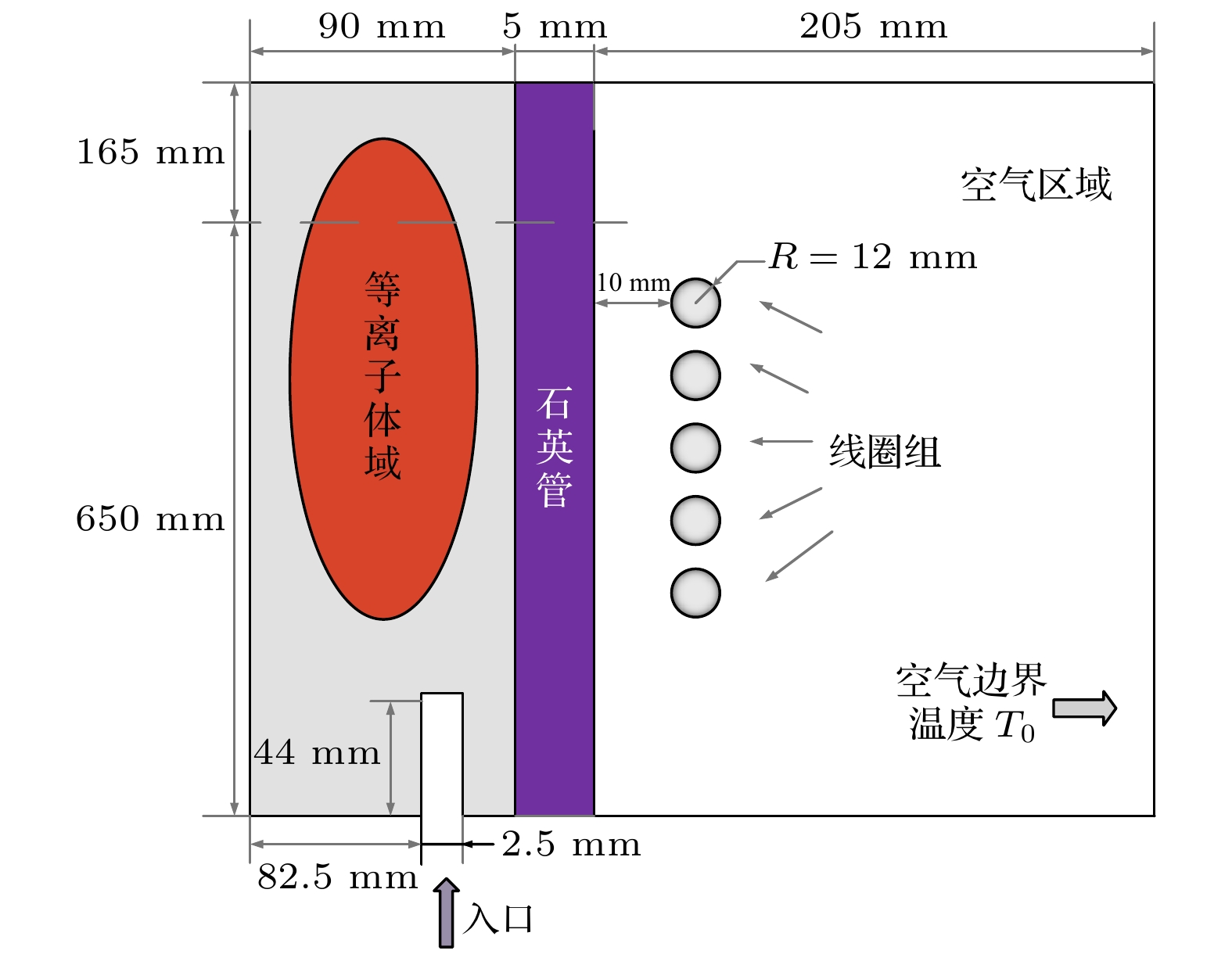
 DownLoad:
DownLoad:



